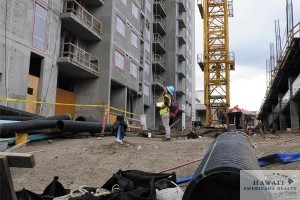
A little more than one-third of the more than 4,200 units being developed in the growing Honolulu neighborhood of Kakaako are not being built for the ultra-rich, the head of the Hawaii agency overseeing the redevelopment of the area said Wednesday.
With scores of high-end condominiums being built in Kakaako, much of the talk has centered around local residents being aced out of area because of not being able to afford such sky-high prices.
Anthony Ching, executive director of the Hawaii Community Development Authority, said at the agency’s monthly meeting amongst a brand new board of directors and new office and meeting spaces at the American Brewery Building in Honolulu, said that 35 percent of all housing units in Kakaako will be for qualified income households.
This means that there is a chunk of units in Kakaako that will be reserved for those in two categories, reserved housing and workforce housing.
Reserved housing is for low or moderate income groups. The majority of “affordable housing” in Kakaako falls under this program.
These developments are available to households making anywhere from 30 percent to 140 percent of area median income, which translates to a person with an annual income between $20,150 and $80,950.
Workforce housing, unlike reserved housing, is not a requirement for residential developers under HCDA rules.
To be called a workforce housing project, the requirements are having at least 75 percent of residential units set aside for those earning between 100 percent and 140 percent area median income, which translates to an annual income for one person between $57,800 and $80,950.
Ching recently told PBN that while the condos being built in Kakaako are all high-value properties, each one has different price points and there is strong local purchase.
“Local investors, as well as occupiers, are part of the significant growth of Kakaako,” he said. “We’re focusing on trying to produce rental units — Halekauwila Place is a good example. It was built with tax credits. The tax credit program is responsible for 90 percent of all low-income housing.”
Duane Shimogawa Reporter – Pacific Business News
